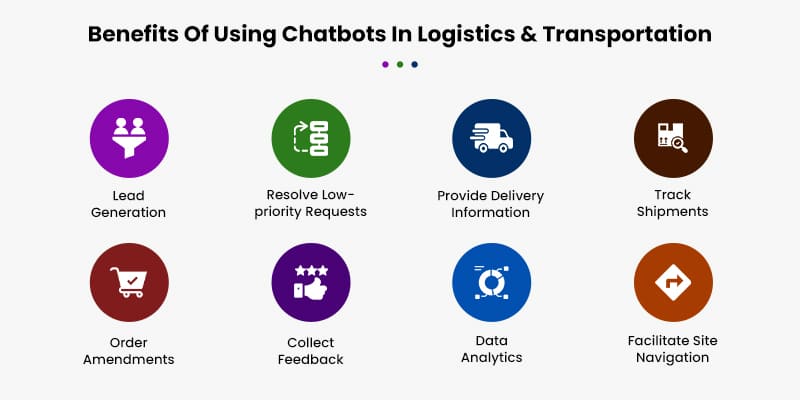
The exponential market growth of chatbots is comparable to very few things today. Just in the short span of five years, it grew approximately 20 times, becoming a market worth USD 3.78 billion in 2021 from a mere USD 190.88 in 2016. And if we were to believe the latest report by Markets and Markets, this growth isn’t going to slow down in the coming future either. As per the report, the market will continue to grow at a CAGR of 23.5% to become a market worth USD 10.5 billion by 2026.
Mostly, this growth is attributed to the rapid digitalization of businesses across sectors, including logistics. The current need for transparency and the unprecedented growth in the volume of online shopping has led to an increase in the demand for round-the-clock availability for logistics businesses, and chatbots just happen to be the most effective and feasible solution for that. This is especially true since, due to advancements in NLP and deep learning, modern chatbots are able to imitate human conversations with staggering accuracy. Conversational AI development has become a boon to logistics businesses, that can now scale their operations without too much additional investment in the back-office processes.
Chatbots and Their Benefits in Logistics & Transportation

Chatbots have made businesses’ support systems more accessible and effective. With the inclusion of deep learning and NLP, they are becoming even more impactful in generating leads, improving customer trust, and automating business processes. This does not only help logistics companies generate more business but also in achieving maximum cost savings. Here are some of the benefits of AI chatbots in a logistics and transportation business.
Read More: Top 10 AI-Based Chatbots For Your Business
Lead Generation
As assisted services are becoming more ubiquitous and accessible, competition is also increasing in logistics and transportation. And since logistics businesses do not have the direct means to increase the demand, competing for the customers already interested is the only way for them to increase business. As such, lead generation is an important part of a logistics business, and chatbots can help them in it.
With an interactive chatbot and engaging content on the website, a website can attract relevant traffic and have them interact with the chatbot much more easily. The details of such visitors can then be used by the sales team to target interested prospects with a more personalized message.
With chatbots, a company can collect both the contact information and analytics, which can collect which kind of content the visitor is interested in. Thereafter, the sales team can pitch business to numerous visitors, all with a personalized message. What’s interesting here is that after some time, this process can be automated to generate leads at an exponential rate helping logistics business scale with ease.
Resolve Low-priority Requests
Logistics businesses are all about volume. As many customers a business can handle in a given time, it becomes the defining factor for its success. Since no matter how many support personnel a business can hire, there is a certain infrastructural limit to how many users they can entertain in a given time.
This is where logistics chatbots enter the picture. Not only do chatbots allow logistics businesses to remain available round-the-clock without hiring additional staff, but they also make the entire process much more efficient.
Since chatbots function based on intent and response, and they can retrieve information in a more accurate and timely fashion, they resolve multiple low-priority requests quickly. These chatbots can also understand which department a query is related to and what additional information the concerned department would require. They can then collect all the needed information from the user, organize it in a structured format, and remove the redundant data, so the department can resolve any given query in the most efficient manner too.
Provide Delivery Information
With a chatbot integrated with the delivery system from the back-end, businesses can easily provide the required delivery information to the clients, sans hassle.
In the absence of an integrated chatbot, the user may have difficulty finding the right tool to retrieve the required information. Furthermore, if the required detail is unavailable in a siloed format, the tools would only offer too much data, which can dissatisfy clients who need a piece of particular information quickly. For example, a client may want to look up the details of a consignment from the order history. The best a database tool can do is provide details of a certain time period, but then retrieval from there can become a challenge for the client.
On the other hand, a chatbot can simplify the entire process by retrieving just the required information by navigating through the more functional databases in the back-end. Thereby, clients would get the needed delivery information in much less time.
Track Shipments
Often logistics companies have tracking mechanisms installed in the back-end of their system. This way, whenever a customer asks for the status of their order, the support staff can quickly look up the database to inform the former of the required update.
Some websites have simplified this functionality by allowing the users to track their orders by entering the unique order ID in a form. Now, while this method is comparatively easier, it has lost the human interaction that many customers prefer.
With an online logistics chatbot system integrated with the tracking system, businesses can provide the best services to their customers. An integrated system will allow customers to ask about their shipment status through purchase order number, tracking ID, or any of their chosen credentials. The chatbot can then retrieve the required information and present it to the customers in a conversational format, improving the customer experience manifold.
Order Amendments
Often when a user places an order, they may forget about certain instructions. Upon remembering the missed details, they would request support staff to make the necessary amendments. This becomes difficult to implement if the business does not keep the support staff functioning 24*7.
As a result, many such amendments reach the concerned department way too late, upsetting the said user. With a chatbot, however, this functionality can be simplified quite easily. From accepting orders to their completion till delivery, the chatbot can keep the user updated about the latest status of their order and enable them to know whether an amendment is possible at the given time in advance.
Chatbots can even be configured to raise alerts to the users to ensure whether they have missed any crucial detail related to the order till the time when no updates in orders can be entertained. This is, in fact, one of the specific functions that are only required by logistics businesses. So, if you’re looking to hire an AI software development company to build your chatbot, ensure that they can develop such custom features.
Collect Feedback
It is a known fact that reviews affect people’s buying decisions, and most people post a review only when they are upset with a product or a service. This means if one does not take enough care about the customer feedback, they can quickly ruin a business’ standing among the target audience.
Similarly, without active inquiry, satisfied customers may not feel inclined to post a review, which, too, can prove to be game-changers in improving a logistics business’ credibility. A chatbot designed to collect feedback will not compel happy customers to push their reviews which can then be used for marketing purposes, but also make dissatisfied customers feel heard, so they don’t post wrong reviews on other online spaces.
The collection of feedback doesn’t end at just the customers’ end. A chatbot with custom AI development integrated with platforms like CRM can help support staff solve high-priority cases at the earliest. Moreover, the feedback log can help the administration determine the recurrent issues with their transportation services. This way, they can make the required changes and improve their services to the customers’ tastes.
Data Analytics
Like feedback, chatbots can collect more relevant data to make data-driven policies and business decisions. In general, data analytics are used by companies from all sectors to gain in-depth insights into customer activities and make better business decisions, and the logistics sector is no exception to that.
A logistics and transportation company can use chatbots to identify major customer challenges. For example, if customers from specific locations have regularly been facing website issues, the company can decide to implement better server services for the given region. Similarly, if customers from just one country have been complaining the most about the customs duty and are yet the most beneficial client-base for the business, special discounts can be offered to them to keep them interested in the company’s services.
Facilitate Site Navigation
Websites for logistics and transportation businesses are not like static websites from most other domains. They need to be functional to answer a large volume of queries and allow customers to place business comparatively easily. As such, navigation for logistics websites can become complex, confusing first-time visitors to find the correct options.
A complex interface or navigation can confound visitors leading them to exit the website without placing a business. This will increase the bounce rates and the website’s organic traffic and damage the brand’s reputation. With chatbots, however, all of this can easily be salvaged.
You can arrange a site tour-like functionality through your live chatbot or simply prompt messages about what the visitor intends to do on the website. Thereafter, the bot can create quick links for the users, making navigation extremely easy for them. This will make the website more user-friendly and improve engagement rates by allowing users to interact on the website in a non-committing manner.
Read More: How to Choose the Right AI-based Chat Bot for Your Business?
How To Implement AI-based Chatbots for Logistics Company?

While most conversational AI tools only require integration with the FAQ section of a business’s online presence, since chatbots in logistics businesses are meant to do more than just answer the frequently asked questions, the implementation process is a little more sophisticated. Here’s a brief overview of what the process would involve-
 Step 1: Create Customer Personas
Step 1: Create Customer Personas
The goal of implementing a chatbot is usually to offer better customer service. While there are other use cases around the tool, its primary purpose remains the same in logistics. To ensure that the product you’re creating is ideal for the target user base, it’s important to understand their requirements, preferences, and expectations fully. To do so, the easiest way forward is to create different customer personas.
For a logistics company, a customer can be an individual looking to send a package for a one-time transaction or a company looking to establish a supply chain. As such the expectations for both the customers would be very different from a chatbot. An option here is to use cookies for registered users and an optional question for the new users to tell whether they’re individuals or an organization. However, this option is outmoded, considering the conversational approach you’re considering taking with chatbot development.
In most cases, you can find the required information for consumer persona creation from the existing platforms like CRMs. All the transactional knowledge can then be fed to machine learning models for categorizing different kinds of customers. Focusing on customers’ context, their questions, and requirements, you can easily create consumer personas, finding their most common intents for interacting with the support system alongside.
 Step 2: Categorize Purposes
Step 2: Categorize Purposes
Once you understand what different kinds of customers your chatbot would be interacting with, you can clearly draw various possible purposes all of them would have to connect with the bot. While most of these purposes would be distinct for every consumer persona, many would overlap multiple personas. This is why it is important to consider these two steps separate from each other.
This stage is mostly about finding various reasons a customer or a prospect would initiate a chat with the bot present on the website. They might be looking for a package deal for recurrent logistics requirements, track an existing order in transit, or ask for a return for a misplaced courier. In any of the given cases, the bot should frame the question differently for a registered company user than a guest user with a one-time transaction. This is why, before you can divide intent and responses through NLP and ML, it is important to categorize the responses, context, personas, and intents carefully to add personalization to every conversation.
 Step 3: Identify Platforms
Step 3: Identify Platforms
Once you have the data and concept cleared for your logistics chatbot, the technological requirements should take the forefront. Decide which platforms you would like to develop your chatbot for. Whether you want to keep it limited to your website and for desktop version only or want it to support the mobile version of your website as well. You may have an app for your logistics business and would like to employ the chatbot there as well. Alternatively, you can create a multi-purpose chatbot with API-based integration on a variety of platforms, including POS systems of your offline outlets. In any case, for your registered users, at least, it is important you offer an omnichannel experience through your chatbot.
This is why, at this stage, at least you should consult with your AI-based chatbot development company and see how soon they can develop the bot for all the different platforms. As your technology partner, they would also be in a better position to tell you which platforms are important for your business, for both the front-end and back-end implementation of the chatbot. They can also decide on the most relevant technologies for the purpose. All you need to do is decide on the private platforms, like mobile app, company website, etc., and public, like Facebook Messenger, WhatsApp, etc., on which you would like to implement the conversational bot.
 Step 4: Build Intents and Responses
Step 4: Build Intents and Responses
Gone is the time when chatbots were simply a conversational tool for the deliverance of FAQs, where users had to select from the given choices of queries, and the bot would simply fetch a static answer. Today, AI-based chatbots are equipped with NLP and can understand complex human language structures to accurately gauge the intent of the user and provide with right answers.
Modern chatbots can also understand the historical context of a conversation and match it with details in the records to answer queries without asking for specific details over and over. As such, if a user has already mentioned that they’ve sent a package to a specific place, and the record says there’s only one such package when the customer asks for tracking details, the bot won’t ask for any more information. It will understand the context, figure out the intent, and then based on the previous conversation, will provide the required information the user has asked for.
To develop such smart chatbots, it is important to build multiple use cases, or possible messages, for every intent. In this step, it is important to either have a deep understanding of conversation engines or hire chatbot developer instead. Knowing how the engine processes each intent based on messages, previous intents, and the bot’s response is important. The consumer persona also plays an important role in every user’s journey maps. This is why, while designing responses and intents, it is important to know the complex mechanisms of the NLP engine or have one custom-built as per your requirements.
 Step 5: Launch and Improve
Step 5: Launch and Improve
Smart chatbots often have more room for improvement post their launch. The feedback loop is an important component in their learning; hence deploying once and then leaving it as it is for use is not a good option for chatbots in logistics. To better understand the importance of this step, understand that a chatbot is an extension of your existing support service. Your support staff must already be working on various intents, and the chatbot must only pick things from there to make them better and more accessible.
Once deployed, these bots must be audited on KPIs like fallout rates, completion rates, and volume of cases covered on various channels. Later, the chatbot would require additional intents to be added to it as per the learning from the feedback loop. It is also important to keep these intents and responses fairly uniform across all the brand platforms to offer customers and prospects an omnichannel experience.
Conclusion
The application of chatbots for the logistics industry is not just for the customers to resolve their queries quicker or for businesses to create more leads but also for the entire staff to bring operational efficiency.
Chatbots, across all the various verticals, are known to offer major cost savings, round-the-clock availability, and an improved brand image. Chatbots in the logistics industry has another added advantage. It can actually automate many customer-oriented processes like order amendments, delivery tracking, and feedback collection. With all these use cases and benefits of chatbots for logistics businesses, it’s no wonder that so many logistics companies are readily investing in AI software development services to build a chatbot with features tailored to their requirements.
Now, while one can easily find an AI development company that would build a chatbot for your logistics business, it is important to understand that you choose one that understands the need for customization. There are anyways so many SaaS-based chatbot solutions available in the market that investing in building one with common features would be a waste. Therefore, the first thing to do is book a consultation call with the company’s experts and discuss your requirements with them to see if they can help. Matellio offers both free consultation calls and an obligation-free project plan report with a free quote to get you started with your chatbot development process right away.

 Step 1: Create Customer Personas
Step 1: Create Customer Personas Step 2: Categorize Purposes
Step 2: Categorize Purposes Step 3: Identify Platforms
Step 3: Identify Platforms Step 4: Build Intents and Responses
Step 4: Build Intents and Responses Step 5: Launch and Improve
Step 5: Launch and Improve


